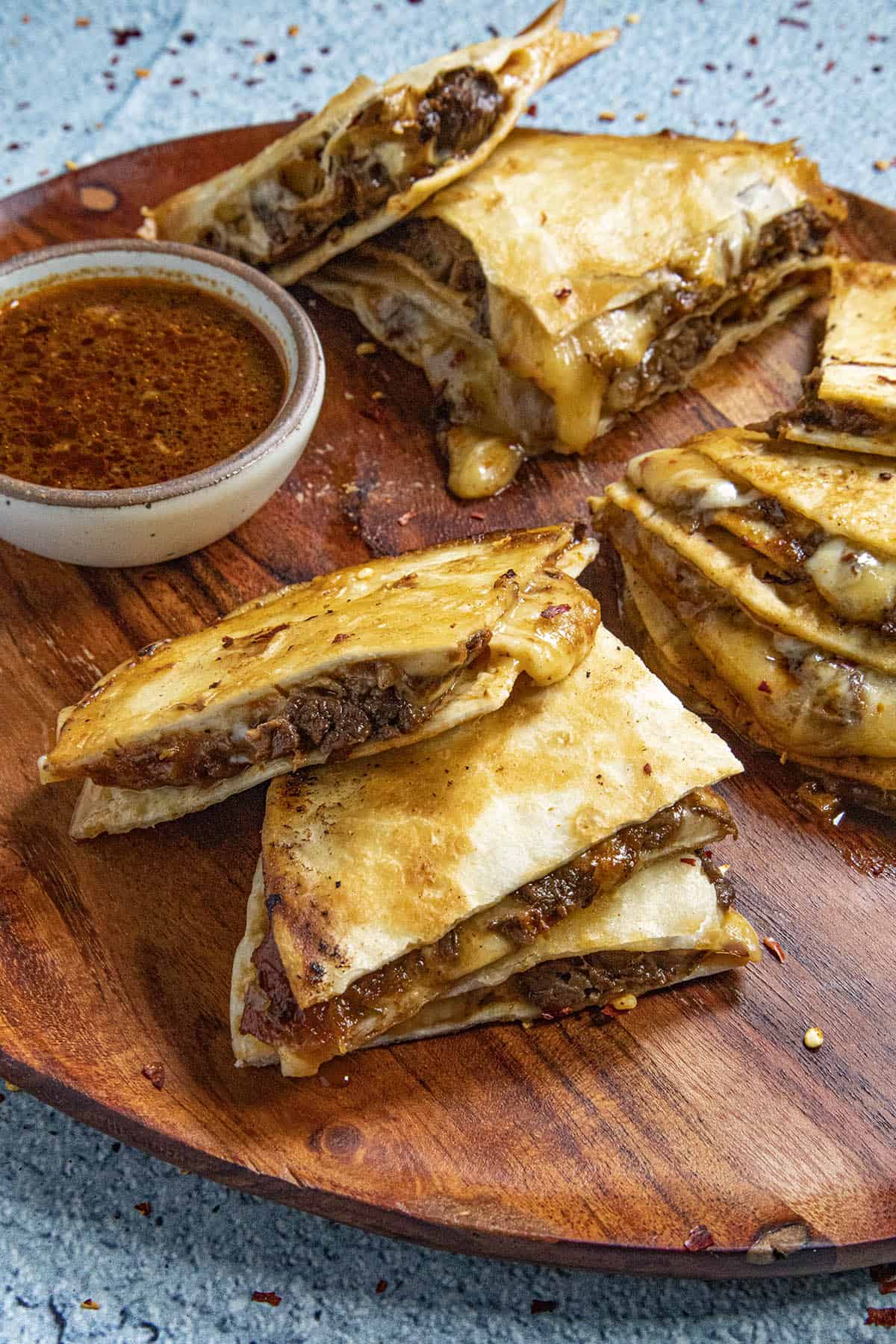Ingredients:
For the Birria Sauce:
- 5 ancho peppers
- 5 guajillo peppers
- 2-3 chiles de arbol (optional for spicier)
- 1 tablespoon vegetable oil
- 1 large white onion, chopped
- 3 large tomatoes, chopped
- 5 cloves garlic, chopped
- 1 tablespoon Mexican oregano
- 1 tablespoon sea salt (or to taste)
- 1 teaspoon cinnamon
- 1 teaspoon cumin
- 1 teaspoon ground ginger
- 1 teaspoon black pepper
- ½ cup apple cider vinegar
- 2 large roasted tomatoes, chopped
- 4 cups beef stock (separated)
- 4 pounds boneless beef chuck (or beef shank, brisket, or lamb shoulder)
For the Birria Quesadillas:
- 2 tablespoons vegetable oil (or more as needed)
- 16 flour tortillas (taco-sized)
- 4 cups shredded Mexican cheese (use any melty cheese, such as Oaxaca, Chihuahua, Pepperjack, or Monterey Jack)
- Optional extras: chopped white or red onion, chopped cilantro, sliced jalapeños
Instructions:
Make the Birria Sauce:
- Safety guideline: Be careful when handling dried peppers. Wear gloves to avoid getting the oils on your skin, as they can irritate your eyes and mouth. If you do get the oils on your skin, wash it thoroughly with soap and water.
- Heat a large pan over medium heat and add the dried peppers. Dry toast them in the hot pan for 1-2 minutes per side, until the skins darken. Remove from heat and add the toasted peppers to a large bowl. Cover with hot water and steep for 20 minutes, or until softened.
- While the peppers are rehydrating, heat the olive oil in the same pan over medium heat. Add the onion and tomatoes and cook for 5 minutes to soften.
- Add the garlic and cook for another minute, stirring.
- Add the cooked onion, tomatoes, and garlic to a food processor.
- Remove the softened chilies and add them to the food processor, but reserve the soaking liquid.
- Add the seasonings to the food processor along with the vinegar and 1 cup beef stock. Process until smooth. It should be fairly thick, but you can thin it if needed with the reserved soaking liquid. Strain the sauce if desired to remove any unprocessed bits of skin.
Make the Birria:
- Safety guideline: Use a clean cutting board and knife to cut the beef, to avoid cross-contamination.
- Cut the beef into large chunks and add it to a large bowl.
- Pour the birria sauce over the beef and rub it into the meat. Cover and marinate the meat in the refrigerator for at least 2 hours, or overnight.
- When you're ready to cook, add the meat with all of the marinade, the chopped roasted tomatoes, and the remaining 3 cups beef broth to a large pot. Cover and cook at medium heat for 3 hours, or until the meat is fork-tender and easy to shred. It should be fairly saucy.
- Shred the meat with forks to your preference. Reserve most of the birria sauce (consome).
Make the Birria Quesadillas:
- Safety guideline: Wash your hands thoroughly with soap and water before handling the tortillas and cheese, to prevent the spread of germs.
- Heat vegetable oil in a large pan or skillet over medium heat.
- Place a tortilla in the pan and spread on ½ cup shredded cheese, then shredded birria meat. Add onions, jalapeños, and cilantro if using. Cook for 1-2 minutes, or until the bottom tortilla becomes crispy.
- Top with another flour tortilla and flip. Cook for another 1-2 minutes, or until the bottom tortilla becomes crispy. Repeat with the remaining tortillas.
- Slice and serve with reserved liquid consome (birria sauce) for dipping.
Enjoy your birria quesadillas!
Safety tips:
- Be careful when handling dried peppers. Wear gloves to avoid getting the oils on your skin.
- Use a clean cutting board and knife to cut the beef, to avoid cross-contamination.
- Wash your hands thoroughly with soap and water before handling the tortillas and cheese, to prevent the spread of germs.
- Cook the meat until it is fork-tender and easy to shred, to ensure that it is safe to eat.
- Serve the quesadillas hot, to prevent the growth of bacteria.












Comments
Post a Comment